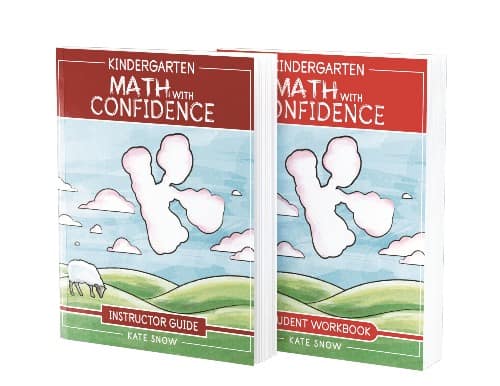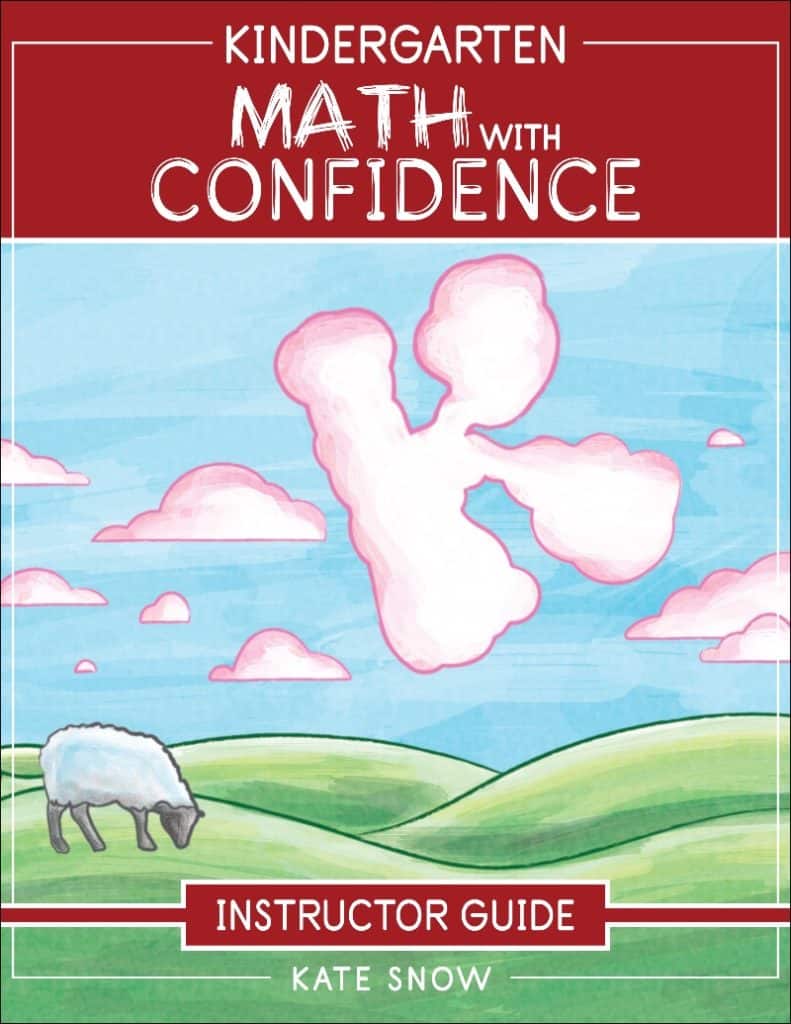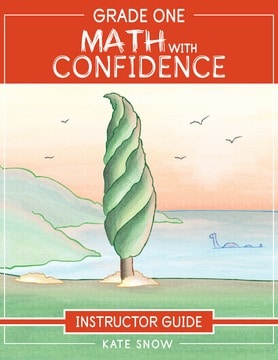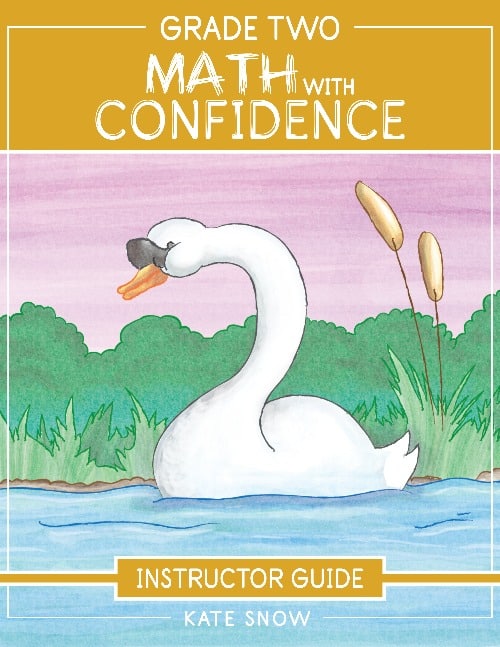Everything you need to know about Math with Confidence, my complete homeschool math curriculum! Teaching philosophy, placement advice, and materials, plus links to grade-level specific info to help you decide whether the program is a good fit for your family.
If you’re like most parents, you’ve probably never taught math before. Math may have not been your best subject in school, and the thought of teaching it may even make you feel a little anxious.
But don’t worry! With my new homeschool math program, I’m here to help you every step of the way.
I’ve taken everything I’ve learned from my years of answering parents’ homeschool math questions and used it to make Math with Confidence as parent-friendly as possible. My hope is that the program will not only help your child learn math with confidence, but also empower you to teach math with confidence!

The Math with Confidence program includes:
- Short, hands-on, and fun lessons
- Lots of games, pretend activities, and real-life contexts
- Complete coverage of all grade-level math topics
- Open-and-go format so you can pick up the book and start teaching
- Friendly, approachable notes and tips that help you grow as a teacher
- Checkpoints at the end of each unit that help you decide whether to spend more time on the current unit or move on to the next one
- Fun (but optional) picture book recommendations and real-life extension activities to help your child enjoy and appreciate math
Below, you’ll find more on the philosophy of the program, what you’ll need, and how to pick the right level. Plus, you’ll find links for specific information about each grade level (like the scope and sequence, a video overview, lesson format, and samples). I hope that having all this info will help you feel well-informed and confident as you decide what program is best for your child. If you have any more questions, just add a comment below and I’ll make sure to respond.
Wishing you all the best in your teaching! Happy Math!

P.S. Kindergarten, First Grade and Second Grade Math with Confidence are available now. Third Grade will be available June 2023. I’ll release a new level of the program each year—see below for the full release schedule.
************************************
What’s the philosophy of the program? Is it mastery or spiral?
The main goal of Math with Confidence is to equip you to raise kids who are confident and capable in math. The program aims to help your child develop a deep understanding of math concepts, proficiency and fluency with fundamental skills, and a positive attitude toward math.
Deep conceptual understanding
You’ll focus on one concept at a time for several weeks so your child can build deep, connected knowledge of each new topic (also known as a mastery approach to new material.) Each new lesson builds on the previous one so your child gradually develops thorough understanding and makes connections between concepts.
Fluency with essential skills
Children need lots of practice to fully master the basics. The Math with Confidence program provides continual, ongoing review so your child fully grasps the core grade-level skills by the end of each year. (This is called a spiral approach to review, because children periodically revisit topics, just as the curve of a spiral returns to the same point on a circle.)
Positive attitude and FUN
The lessons include lots of games, pretend activities, and hands-on learning so your child enjoys and even looks forward to math time. I’ve also added weekly (optional) suggestions for picture books and math extension activities to provide a break from the daily routine and help your child appreciate how math is used in real life.
What do I need to teach Math with Confidence?
Instructor Guide and Student Workbook
You’ll need two books to teach each grade: the Instructor Guide and Student Workbook.
- The Instructor Guide is the core of the program, with conversational and hands-on activities and games that teach the key skills and concepts. It’s scripted and open-and-go so you can just pick up the book and start teaching.
- The colorful Student Workbook provides written practice and review.
I’m thrilled that Well-Trained Mind Press is able to offer the program for about $50, which includes both the Instructor Guide and full-color Student Workbook. Each retailer sets their own price, so you may even be able to find it for less.
Manipulatives
Besides these two books, you’ll need a simple kit of household materials to make math hands-on for your child. You probably already own just about everything you need: counters, coins, a clock, a ruler, etc. You’ll also sometimes use household items like stuffed animals, small toys, or crayons.
Which level is best for my child?
Math with Confidence is a “middle-of-the-road” program in terms of difficulty. In general, use the grade level that corresponds to your child’s age. There’s just a few key skills that your child should have mastered before beginning. Check out this article for lots more details, plus answers to frequently asked placement questions:
Will there be other grades? Is Math with Confidence a full series?
Yes! Math with Confidence will eventually be a full program from kindergarten through sixth grade, with one new level released each year. If you use Kindergarten, First Grade, or Second Grade in the 2022-2023 academic year, you’ll be all set moving forward.
Where can I buy Math with Confidence books?
Print copies are available at Amazon, Well-Trained Mind Press, and other major homeschool booksellers. Digital copies (PDFs) are available only from Well-Trained Mind Press. You’ll find direct links to the books at Amazon and Well-Trained Mind Press below, along with links to more information for each grade level. Happy Math!
Kindergarten Math with Confidence
First Grade Math with Confidence
Second Grade Math with Confidence
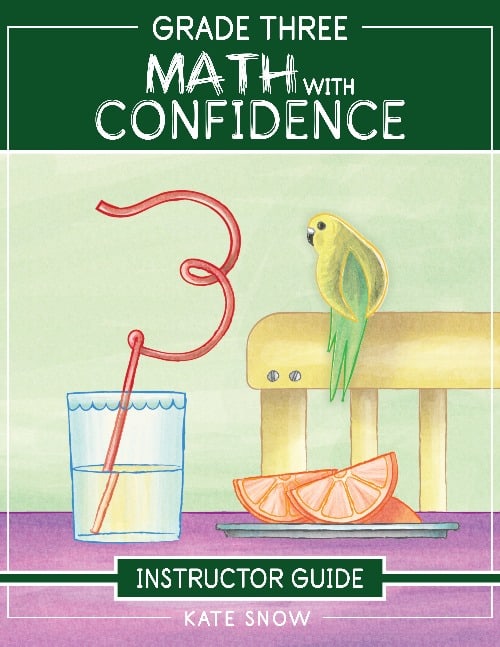
Third Grade Math with Confidence
- Coming in June 2023
- Click here for the scope and sequence, lesson details, and placement info.

Fourth Grade Math with Confidence
- Coming in Summer 2024
- Scope and sequence (tentative)
- Understand place value in numbers to one million
- Identify factors or multiples of numbers and tell whether numbers are prime or composite
- Solve multiplication problems (up to four-digit times one-digit and two-digit times two-digit)
- Use long division to solve division problems (up to four-digit divided by one-digit)
- Convert improper fractions to mixed numbers and vice versa
- Add and subtract fractions and mixed numbers with like denominators
- Multiply fractions by whole numbers
- Find equivalent fractions
- Read, write, compare, and order decimals to the hundredths place
- Solve measurement problems and convert measurements within a system of measurement (for example, inches to feet, or kilograms to grams)
- Measure, draw, compare, and reason about angles
- Identify and categorize triangles and quadrilaterals
- Create and interpret line plots
- Find averages

Fifth Grade Math with Confidence
- Coming in Summer 2025
- Scope and sequence (tentative)
- Understand place value to billions
- Use the order of operations
- Review multi-digit multiplication and long division (including multiplication up to three digits times three digits, and long division up to four digits divided by two digits)
- Add and subtract fractions and mixed numbers with different denominators
- Multiply fractions and mixed numbers
- Solve simple fraction division problems and understand the concept of fraction division
- Read, write, and compare decimals to the thousandths-place
- Add, subtract, multiply, and divide decimals
- Solve multi-step word problems with fractions and decimals
- Use fractions and decimals to express and convert measurements
- Find the volume of rectangular prisms
- Graph points on the coordinate grid (positive coordinates only)
- Understand line graphs and use the coordinate grid to solve real-world problems
- Reason about triangles and quadrilaterals

Sixth Grade Math with Confidence
- Coming in Summer 2026
- Scope and sequence (tentative)
- Review addition, subtraction, multiplication, and division with whole numbers
- Understand exponents and square numbers
- Multiply and divide fractions, mixed numbers, and decimals
- Use ratios and proportional thinking to solve problems involving speed, rate, and unit prices
- Calculate percentages and use percentages to solve real-life problems
- Use variables to write and solve simple equations
- Add, subtract, multiply, and divide positive and negative integers
- Graph points on the coordinate grid and use to solve problems
- Find the volume and surface area of solid figures
- Find the area of triangles and parallelograms
- Create line plots, histograms, and stem-and-leaf plots and reason about data distributions
- Calculate the mean, median, and mode for data sets

